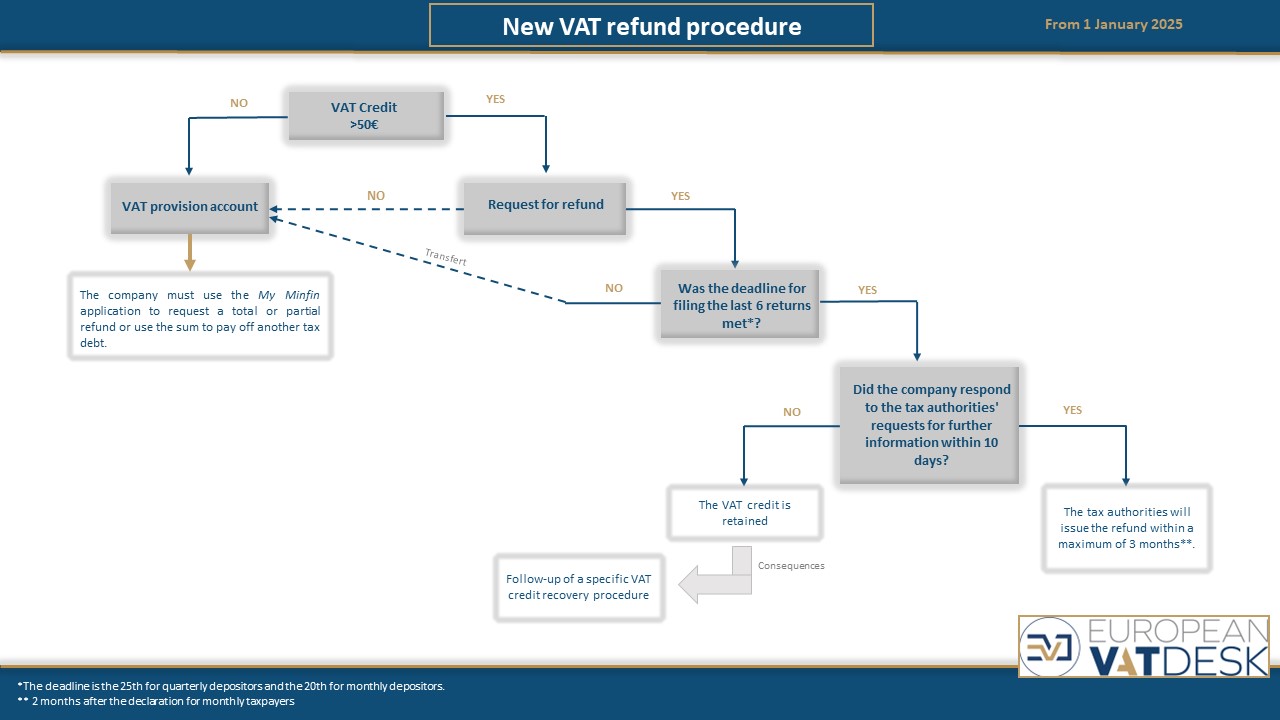The Author of the Article
Changes to VAT refunds from 1 January 2025
Businesses can obtain the refund of VAT credit arising from their VAT returns.
As of January 1st 2025, the VAT credit refund procedure for Belgian tax-payers will be significantly modified.
According to the tax authorities, this change will greatly benefit to businesses. When it comes to VAT, however, the devil lies often in the details. It is therefore important to keep on acting with caution in the face of the new traps and pitfalls entailed in the new refund process.
Summary diagram

The new rules
The fundamental principles of the new scheme are as follows:
- VAT credit can be refunded when it exceeds €50, regardless of the period concerned (currently set at €400).
- It is no longer possible to offset the existing VAT credit at the beginning with VAT situation at the end of another period. The VAT credit is therefore no longer automatically carried forward by the tax authorities to the next period. From now on, each period must be managed separately.
- The VAT refund request will only be approved by the tax authorities provided the last 6 VAT returns have been submitted on time, and if the applicant has answered within 10 working days to any request of additional information issued by the tax authorities.
- Generalization of monthly refunds for monthly filers (special authorization no longer required).
Practicalities
If your company has a VAT credit at the end of a period, it now has two options:
- It does not apply for a refund. In this situation, the tax authorities automatically transfer the VAT credit to a “VAT provision account”. The company must then manage the VAT credit via the “My Minfin” application, by requesting a total or partial refund, or by offsetting the VAT credit against tax liabilities.
- This is done by explicitly requesting repayment by ticking the appropriate box on the tax return. In this situation, the tax authorities will proceed with the refund within a maximum of three months (art. 76, §1 of the CTVA) following the end of the declaration period, provided that the following criteria are met:
1) All VAT declarations for the six months preceding the declaration period have been submitted on time (i.e. by the 20th or 25th of the month, depending on whether declarations are monthly or quarterly). In view of its importance, this condition, which had already been incorporated in a Royal Decree, has now been incorporated in the legislative act itself. The old administrative tolerances avoiding fines in the event of a slight delay in filing, or allowing an extension of the deadline during the summer period, thus seem to become obsolete, barring a last-minute reversal.
2) The company has provided, where applicable, an adequate response to any request of information issued by the tax authorities within the shortened 10-day deadline.
If either of the two deadlines is not met, the VAT refund application will be rejected. In this case, the VAT credit will either be transferred to the company's VAT provision account (in the event of failure to meet the deadline for filing returns), or withheld (in the event of failure to meet the deadline for responding to the request for information). You will then have to follow a specific procedure to get your money back.
The VAT expert's eye
In Belgium, administrative tolerances have been in place for 40 years, allowing a certain flexibility in VAT filing deadlines. The administration does not penalize slightly late filings, and each year publishes a communication on the extension of deadlines during the summer period. Similarly, the offsetting of VAT liabilities against VAT credit during a quarter is a well-established rule for all.
From January 1, 2025, it will be essential to change your habits to avoid fines and VAT credit blocking by the tax authorities.
A wise accountant is worth two.